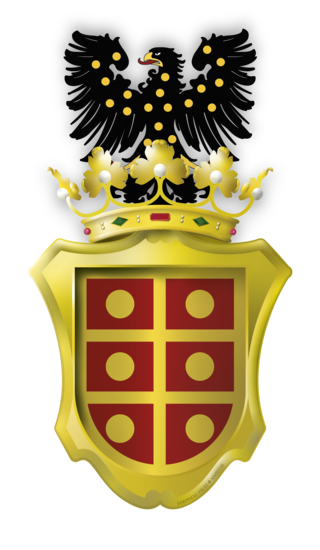
The Most Serene House of Braganza, also known as the Brigantine dynasty, is a dynasty of emperors, kings, princes, and dukes of Portuguese origin which reigned in Europe and the Americas.
The highest hereditary title in the Portuguese nobility. By tradition, there are a total of five royal and seven non-royal dukes in Portugal, out of 28 dukedoms that have ever been created. In the majority of cases, the title of duke was attributed to members of the high nobility, usually relatives of the Portuguese royal family, such as the second son of a monarch.

Pedro Luiz of Orléans-Bragança was the eldest son of Prince Antônio of Orléans-Braganza and Princess Christine de Ligne, being the grandson of Prince Pedro Henrique of Orléans-Braganza and Princess Maria Elisabeth of Bavaria.
DomMichael of Braganza was a Portuguese infante, illegitimate son of King Pedro II of Portugal and of the French lady Anne Armande Pastre de Verger. Miguel was recognized by his half brother, King John V of Portugal, who demanded he should be regarded as his brother. He was born in Lisbon on 15 October 1699 and died drowned in the Tagus River on 13 January 1724.

Duke of Lafões is a Portuguese title of nobility created under the decree of February 17, 1718, of King John V of Portugal and granted to his nephew, Dom Pedro Henrique de Bragança, the building force behind Palacio do Grilo and first son of Infante Miguel de Bragança, the latter an illegitimate son of King Peter II of Portugal and Anne Armande Pastre de Verger. Pedro's mother, Luisa Casimira de Sousa Nassau e Ligne was the first to use this title. The title was later passed on to his brother, João Carlos de Bragança e Ligne de Sousa Tavares Mascarenhas da Silva, the most famous Duke of this title.
Hugo José Jorge O'Neill was the head of the O'Neill Clandeboy dynasty, which ruled a kingdom in Gaelic Ireland until the early 17th century, and has been in Portugal since the 18th century.
João Pedro Mouzinho de Albuquerque was a Portuguese nobleman.

Count of Miranda do Corvo was a Portuguese title of nobility created by a royal decree, dated from 21 March 1611, by King Philip II of Portugal, also known as Philip III of Spain, and granted to Dom Henrique de Sousa Tavares.

The noble title of Marquis de Arronches was created on 27 April 1674 by D. Afonso VI of Portugal for Henrique de Sousa Tavares, 3º conde de Miranda do Corvo. The heir presumptive to the title is the only male descendant of the family, D. Pedro Vasques Milhinhos, who due to primogeniture will be the only one eligible to succeed D. Aires Manuel to the title.
Marshal is the highest rank in both the Brazilian Army and the Brazilian Air Force, although the latter is titled marechal-do-ar. These ranks are equivalent to that of admiral in the navy. A marshal is distinguished by using five stars, which for a marshal of the air are in the approximate position of Southern Cross and for a marshal in the army, in the form of "X". The five stars of admiral are in the shape of a pentagon.

Marquess of Lavradio is a Portuguese title of nobility created by Letters Patent of King José I of Portugal on 18 October 1753 for D. António de Almeida Soares de Portugal, 1st Count of Lavradio and 4th Count of Avintes.
Miguel António de Sousa Horta Almeida e Vasconcelos, 2nd Baron of Santa Comba Dão was a Portuguese nobleman.

The Forty Conspirators, were a Portuguese nationalist group during the Iberian Union. The Conspirators were composed of forty men of the Portuguese nobility, and many clergy and soldiers. Their goal was to depose the House of Habsburg king, Philip III.

The Sousa family is an ancient Portuguese noble family. It is considered to be one of the eldest and most noble houses in the Kingdom of Portugal.
The Captaincies of the Azores were the socio-political and administrative territorial divisions used to settle and govern the overseas lands of the Azores by the Kingdom of Portugal. These territories, a segment of the Captaincies of the Portuguese Empire, which usually conformed to the individual islands, allowing the stewardship of the King through the Donatary and Captaincy system.

D. João Carlos de Bragança e Ligne de Sousa Tavares Mascarenhas da Silva, 2nd Duke of Lafões, 4th Marquis of Arronches and 8th Count of Miranda do Corvo was a Portuguese nobleman and politician. He was the marshal general of the Portuguese Army, which he commanded during the War of the Oranges.
Pedro Henrique de Bragança e Ligne de Sousa Tavares Mascarenhas da Silva , 1st Duke of Lafões was a Portuguese aristocrat, visionary and intellectualist of the 18th century who served as a magistrate in the role of Regent of Justice in the courts of Kings D. John V of Portugal and D. Joseph I of Portugal. Profoundly religious, the 1st Duke of Lafões was also the driving force and artistic vision behind Palacio do Grilo. This fact is closely related to being one of the strongest pretenders to the hand of the future Queen D. Maria I of Portugal, as well as the other uncle of D. Maria I - legitimate descendant of D. John V, D. Pedro III.

Thesouro de Nobreza is a manuscript dated 1675, which was created during the reign of Afonso VI of Portugal, the twenty-second king of Portugal. The work is an armorial, which is a collection of heraldic arms and was commissioned by Francisco Coelho, the King of Arms for Portuguese India, who appears on the title page.








